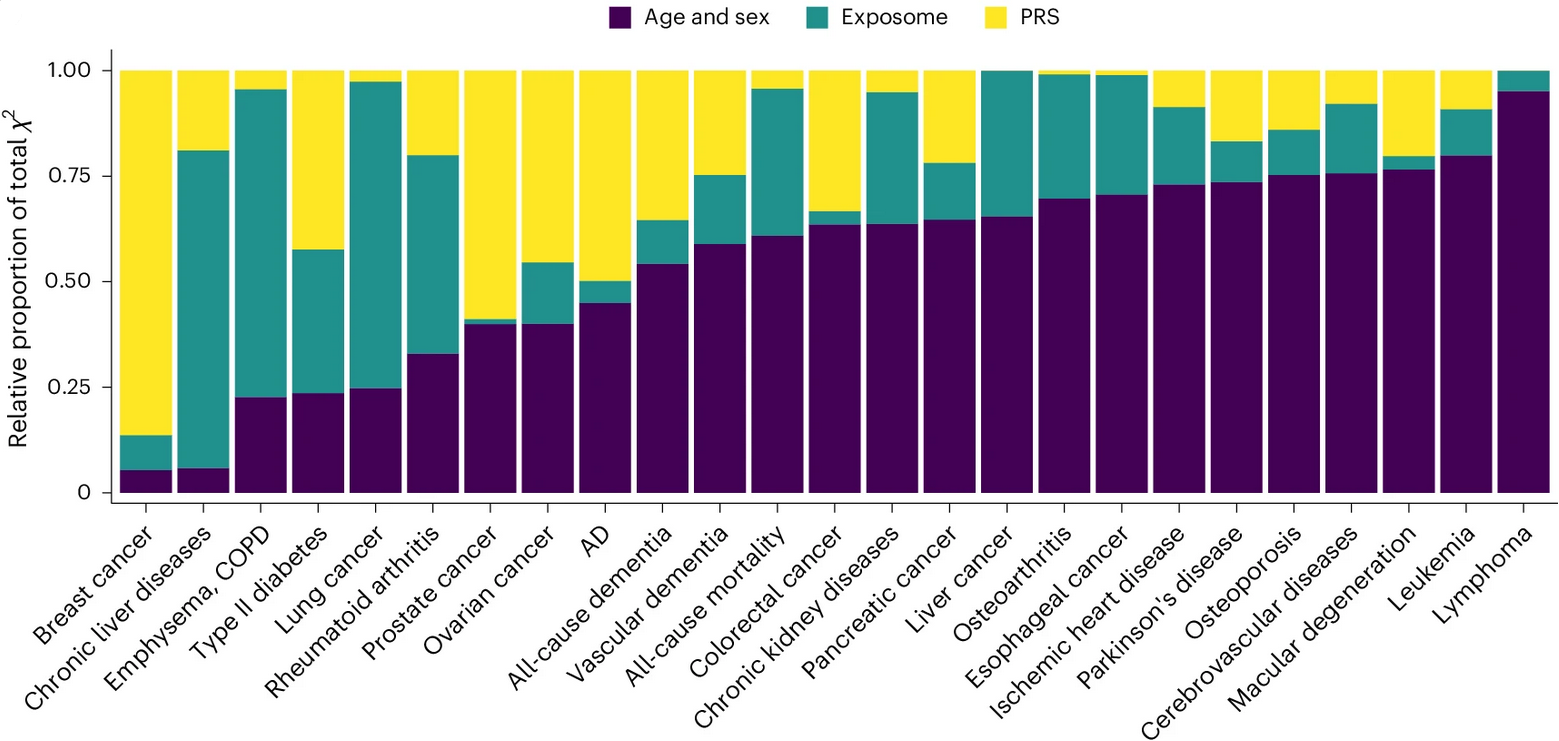Nature versus Nurture
Binary oppositions come easily to the human mind. Good and evil. Joy and sadness. Chalk and cheese. But, attracted as we are to neat categories, one question is whether these clean absolutes always exist in reality? Recent research in Nature Medicine exemplified this very question by considering the relative importance of nature (genetics) versus nurture (environment) in the study of human mortality and morbidity.
The tool used to examine nurture as a driver for mortality and morbidity was that of the exposome, which in the broadest sense was defined as "the total set of interrelated environmental exposures throughout the life course." The researchers began with a wide range of 164 different exposures including to social hardships such as unemployment or deprivation, lifestyle exposures such as to alcohol or smoking, well-being exposures including to exercise, noise pollution and green space, alongside psychological exposures such as to anxiety or depression. These exposures were tested for association with mortality using a Cox proportional hazards model, and these model results were validated against a replication set of UK Biobank members. After replication, 85 exposures remained under consideration.
The second framework considered was that of genetically-driven mortality and morbidity. The paper built on earlier work by the same team published in 2024, where they developed a proteomic aging clock to provide a measure of biological aging based on circulating blood proteins. The clock, based on 204 proteins was found to accurately predict not just chronological age, but also the incidence of 18 major diseases, all-cause mortality risk and biological measures such as frailty and telomere length. This clock was developed against UK BioBank data, and then validated against similar datasets from China and Finland.
To sense-check the environmental exposures, the list was further filtered to only those with a mortality effect consistent with the proteomic clock (i.e having an effect in the same direction as proteomic aging). This filtering left 28 exposures significantly and consistently associated with both premature mortality and biological aging. To complete the analysis, the third and final mortality driver under consideration was that of chronological age and sex.
These three drivers of mortality and morbidity: the environmental (Exposome), genetic polygenic risk score (PRS) and the combination of age and sex, were then compared against 25 different mortality and disease outcomes. Practitioners of mortality experience analysis would be unsurprised to learn that the combination of age and sex continued to be a dominant driver of the majority of outcomes. Perhaps more surprising were the clear differences in relevance between genetic or proteomic and the environmental (exposome) risk for different conditions. The researchers created the following summary chart about the explanatory contribution of the three approaches:

Click to see chart in new tab.
While the above chart makes things appear very clean and categorical, certain questions naturally arise. Most notably, there are a plethora of examples in the literature where environmental exposures themselves appear to drive proteomic effects. One illustration is found in this recent preprint paper on physical activity, also based on the UK BioBank data, which found physical activity had clear associations with circulating blood proteins. We can find evidence of a similar situation with all of smoking, depression and obesity. Given what appear to be clear feeds from the environment into any proteomic signature, it seems possible that an attempt to contrast proteomics with environment might under-represent the role of environmental exposures.
Whatever way we consider matters, however, a key finding from this research is that after deducting the contribution of age and sex, the primary driver for the majority of outcomes considered proved to be environmental. Further, the list of environmental exposures analysed were, in 23 from 25 cases, potentially modifiable. This should provide some cause for good cheer: even if we can't yet honestly claim that age is just a number, this research proves that for many serious diseases, genes are very far from being our destiny...
References:
Argentieri, M.A., Amin, N., Nevado-Holgado, A.J. et al. Integrating the environmental and genetic architectures of aging and mortality. Nat Med (2025). https://doi.org/10.1038/s41591-024-03483-9
Arani, G., Arora, A. et al. IPlasma Proteomic Signatures of Physical Activity Provide Insights into Biological Impacts of Physical Activity and its Protective Role Against Dementia medRxiv [Preprint] https://doi.org/10.1101/2025.01.16.25320290
Yang, M., Kohler, M., Heyder, T. et al. Long-term smoking alters abundance of over half of the proteome in bronchoalveolar lavage cell in smokers with normal spirometry, with effects on molecular pathways associated with COPD. Respir Res 19, 40 (2018). https://doi.org/10.1186/s12931-017-0695-6
Bot M, Chan MK, Jansen R, Lamers F, Vogelzangs N, Steiner J, Leweke FM, Rothermundt M, Cooper J, Bahn S, Penninx BW. Serum proteomic profiling of major depressive disorder. Transl Psychiatry. (2015) https://doi.org/10.1038/tp.2015.88
Previous posts
200 years of Gompertz
Today is the 200th anniversary of Benjamin Gompertz's reading of his famous paper before the Royal Society of London. Generations of actuaries and demographers are familiar with his law of mortality:
\[\mu_x = e^{\alpha+\beta x}\qquad(1),\]
The Doctrine of Probabilities
I rediscovered my Faculty of Actuaries diploma recently, having misplaced it in a house move some years ago. It testifies to my knowledge of ‘the doctrine of probabilities’, which is nice. But not long after I received it, Prof Hans Bühlmann classified actuaries like me as ‘Actuaries of the First Kind’ and said:
Contrary to [the Actuary] of the First Kind in life assurance, whose methods were essentially deterministic, [the Actuary of the Second Kind] had to master the skills of probabilistic thinking.


Add new comment